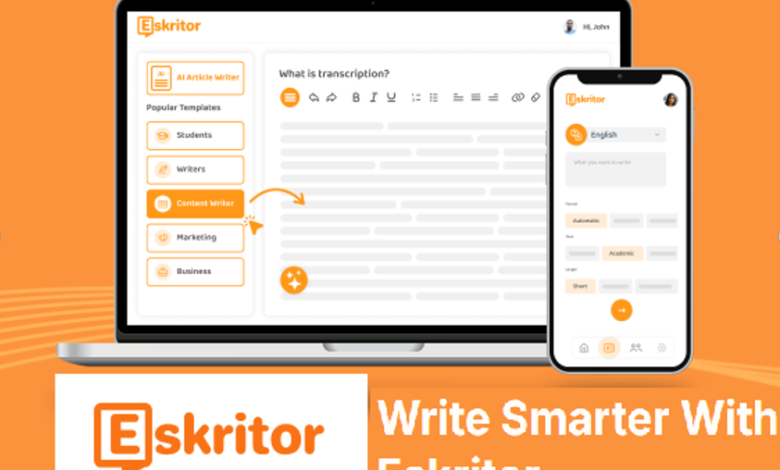Persuasion Meets Precision: How AI Is Changing the Business Proposal Game

A New Era in Business Communication
Crafting a compelling business proposal has always been a blend of logic and persuasion. It’s where data meets storytelling, structure meets creativity, and time constraints collide with expectations. But in today’s fast-paced economy, the stakes are higher than ever. Companies are expected to deliver high-quality proposals at speed, across languages, industries, and contexts. The traditional proposal process, often bogged down by manual edits, formatting errors, and inconsistent tone, simply cannot keep up.
This growing demand for accuracy, clarity, and speed has led many businesses to adopt AI-powered writing tools. These tools aren’t just about spelling correction or grammar checks. They’re reshaping how we plan, draft, and present the very structure of a business proposal. One such tool is Eskritor, a multilingual AI writing platform designed to generate long-form written content that adapts to both corporate and creative use cases. You’ll find its features aligned with the evolving expectations of today’s proposal writers.
Beyond Templates: Personalization at Scale
Traditionally, businesses have relied on templates or recycled content when responding to requests for proposals (RFPs) or pitching new partnerships. While this saves time, it often comes at the cost of relevance and customization. One of the key advantages of using an AI tool for a business proposal is its ability to produce context-aware content that adapts to the specific goals, industries, and tone of a project. AI writing engines can be trained on past proposals, enabling them to generate fresh material while staying consistent with a company’s voice.
This is especially valuable for agencies, startups, or consultancies that deal with diverse clients. Rather than tweaking the same pitch repeatedly, users can prompt an AI engine with client-specific data points and receive a tailored proposal in return- one that sounds human, stays on message, and avoids redundancy.
Reducing Human Bottlenecks Without Losing the Human Touch
AI writing tools do not replace human strategy, but they do eliminate bottlenecks in the drafting process. From organizing sections (executive summary, budget, scope) to refining tone based on audience (investors, government bodies, partners), these tools help writers skip the grunt work and focus on the strategic elements of persuasion.
Eskritor, for example, offers generation features that allow users to create proposals in multiple languages with consistent tone, length, and structure. Its AI understands how to handle domain-specific vocabulary while still sounding natural, which is especially useful when working with international teams or clients. This can significantly cut the time spent translating or rewriting core content for different regions.
Language, Tone, and the Globalization of Business Proposals
Proposals are no longer confined to one language or one market. Today’s businesses must be able to pitch across borders, cultures, and expectations. Tone becomes as important as content. Too casual, and you may lose credibility; too formal, and you may seem distant. The adaptability of AI-generated writing ensures that tone shifts can be managed with precision. Users can adjust prompts to specify the desired tone- confident, neutral, diplomatic and the AI engine can fine-tune accordingly.
This is where platforms like Eskritor stand out. By supporting multilingual writing and tone-specific generation, they make cross-border pitching more scalable. Whether you’re writing in English, Spanish, or Turkish, the final result doesn’t just sound like a translation. It reads like it was written by a native speaker for a specific market.
See also: Dr. Ben Lynch’s Guide to Personalized Supplementation
From Bullet Points to Full Drafts: Structuring Ideas with Speed
Even experienced business writers often begin with an outline- bullet points on key value propositions, timelines, or pricing. The challenge lies in turning those raw ideas into a cohesive draft that flows logically and persuasively. AI tools help bridge this gap.
A common workflow looks like this: a user inputs the proposal’s objective, key deliverables, and supporting points. The AI then generates full paragraphs under each section, often producing a complete first draft in minutes. Rather than writing from scratch, teams can begin with a strong base and revise collaboratively. This speeds up internal workflows and frees up time for higher-level strategy.
Accuracy and Compliance: Getting the Details Right
While creative language matters, proposals must also get the numbers right. Dates, timelines, pricing tiers, and deliverables are non-negotiable. AI tools trained on company-specific data sets can assist in ensuring consistent details across all sections. And because AI-generated content can be audited and stored, it’s easier to track which version of a proposal went where, improving compliance and accountability.
Companies using AI for proposal generation often report fewer inconsistencies in their submissions. That alone can improve chances of approval, as sloppiness- whether in formatting or factual content is often interpreted as a lack of professionalism.
Collaboration, Not Replacement
One of the biggest misconceptions about AI writing tools is that they’re here to replace human writers. But in practice, these platforms work best when used as collaborative partners. Think of them as a co-author who never sleeps. Writers still make key strategic decisions: What’s the main value proposition? Who is the decision-maker? What tone best reflects the brand? But once these inputs are clear, the AI takes over the heavy lifting of drafting.
For proposal teams that involve sales reps, project managers, and content strategists, this collaborative process ensures consistency and cuts down on endless revision cycles. Writing becomes a shared process, rather than a task passed from one department to the next.
Final Thoughts: Business Writing for the Modern Age
The business proposal has always been a hybrid form of writing part persuasive essay, part formal document, part brand story. As companies grow more agile and globalized, the demands placed on these documents continue to rise. AI writing tools are meeting those demands not by replacing expertise but by enhancing it. They bring speed without sacrificing tone, precision without losing persuasion.
Tools like Eskritor are leading this shift by enabling users to move from outlines to finished documents with accuracy, coherence, and adaptability. Whether you’re an independent consultant or part of a corporate sales team, AI-driven writing platforms are no longer optional. They are becoming the standard infrastructure of modern proposal writing.
For those exploring AI assistance in their writing workflow, Eskritor offers a compelling solution, providing multilingual support, genre control, and adaptive tone tuning, all within a clean, usable interface. As expectations for business communication evolve, AI is no longer just a convenience. It’s becoming a competitive advantage.






